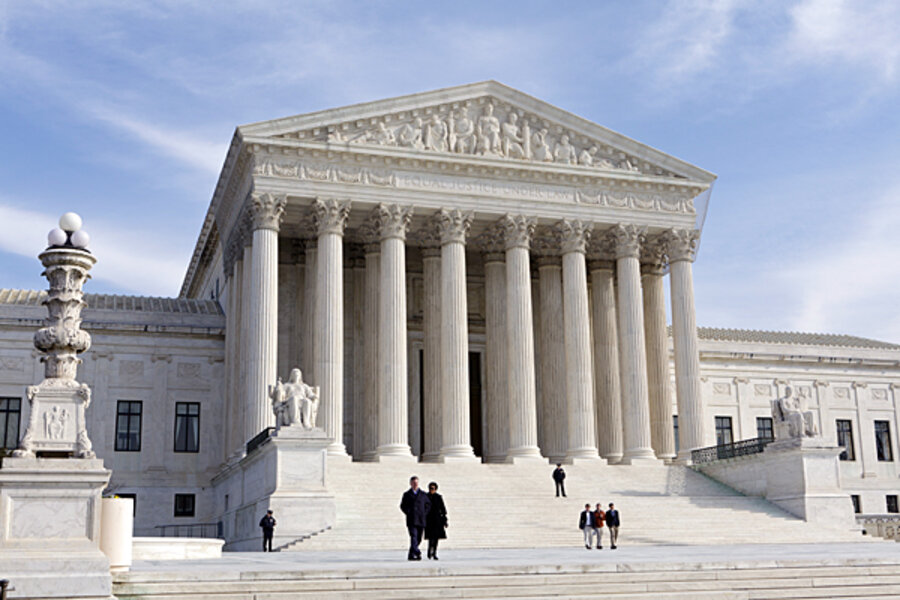Supreme Court on TV? Senate panel advances bill requiring cameras in high court.
The Senate Judiciary Committee voted 11 to 7 on Thursday in support of a bill that would require live video broadcasts of arguments at the US Supreme Court.
The bill, S1945, mandates live audio and visual coverage of all open sessions at the high court unless a majority of justices decide that such coverage in a particular case would violate the due process rights of any party involved.
The action comes as the Supreme Court prepares for an extraordinary five and a half hours of argument over three days in late March in a potential landmark challenge to President Obama’s health-care reform law. The case is drawing substantial national interest, but the public section of the courtroom is relatively small and cameras are not allowed.
“The Supreme Court decision will impact all Americans,” Judiciary Committee Chair Patrick Leahy (D) of Vermont said. “It is no surprise that there is tremendous public interest in witnessing these historic arguments.”
Passage by the Senate and the House is uncertain. The action marks the sixth time such a bill has been voted out of the judiciary committee and sent to the full Senate.
“I know that some justices are not fans of televising their proceedings,” Senator Leahy said. “I understand that they do not want to be made fun of through an unflattering video clip or to be quoted out of context. But that happens to the rest of us in public service all the time,” he said.
“It is not particularly pleasant, but it is part of our democracy,” Leahy said.
California Senator Dianne Feinstein was the only Democrat on the Judiciary Committee to vote against the bill. “The court does not want this,” she said. “I don’t believe we should tell the Supreme Court what to do. We are separate branches of government.”
She added that the spectacle of the O.J. Simpson case had convinced her that “because something is televised does not necessarily mean that justice is better.”
The measure is co-sponsored by Sen. Dick Durban (D) of Illinois and Sen. Chuck Grassley (R) of Iowa. Texas Republican Sen. John Cornyn joined Senator Grassley in supporting the bill, but the six other Republicans on the committee voted no.
During an October Senate hearing on the role of the judiciary, Justices Antonin Scalia and Stephen Breyer were asked their views on whether high court sessions should be broadcast live.
“When I first came to the court … I was initially in favor of televising arguments, but the longer I have been there, the less good an idea I think it is,” Justice Scalia told the senators in a televised hearing Oct. 5.
“If I really thought the American people would get educated, I would be all for it,” he said. But most people rather than watching the entire case would rely on summaries and truncated reports that would likely create misperceptions, he said.
“For every ten people who sat through our proceedings gavel to gavel, there would be 10,000 who would see nothing but a 30-second outtake from one of the proceedings, which I guarantee you would not be representative of what we do,” Scalia said.
Justice Breyer agreed, but for a slightly different reason.
“We are trustees [of a cherished institution]. And we do not want to make a decision that will be nonreversible and hurt the court,” he said.
Nonetheless, Breyer told the senators there are times at the high court where history and law dramatically converge in a case, forcing the justices to confront and decide a difficult constitutional dilemma. Those are the cases, he said, where it would be good for the court and for the public to have greater access.
But Breyer said more research was necessary to convince him to allow cameras at the Supreme Court. “Maybe eventually … it will just seem weird, what we do now [barring live broadcasts], and it will all change,” Breyer said.
Leahy recalled Breyer’s earlier statement. “I think that time has come,” he said. “When so many cell phones are equipped with a video camera and with the advent of YouTube and ubiquitousness of the Internet, there is very little that is not able to be viewed.”
“It is time for the Supreme Court to open its arguments to the American people – not just those members of the Supreme Court bar who have seats reserved in the hearing room,” Leahy said.
Grassley said he and Senator Chuck Schumer (D) of New York had urged the court to allow live broadcasts during the 2000 Florida recount cases, Bush v. Gore. The court responded by releasing an audio recording shortly after the arguments.
“It was a sign of progress that gave the entire country the opportunity to experience what so few get to: the Supreme Court at work,” Grassley said.
In 2010, the court, under Chief Justice John Roberts, began releasing audio tapes of argument sessions at the end of each week, he added. The court also releases a full transcript of each argument a few hours after the argument.
Grassley said these are steps in the right direction. “But it’s not enough,” he said.
Leahy noted that Sunday’s Super Bowl drew 11 million viewers. “No one would have tolerated that game being recorded and broadcast days later or its plays being transcribed and released at the end of the week,” he said.
“The outcome of the Supreme Court argument next month … will affect Americans more than the outcome of any football game,” he said.





